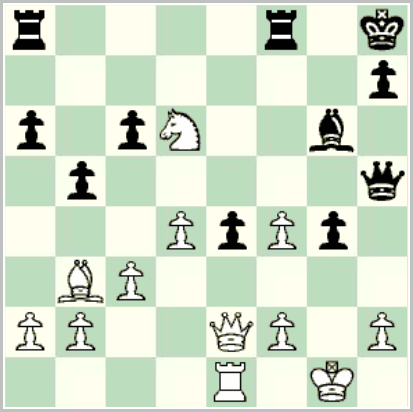Happy New Year, and best wishes for 2016!
For this first post of the new year, let’s turn to the next ‘new’ game from J.J. Walsh’s unpublished manuscript of selected Irish games 1896-1967. It’s an historic one, as a matter of fact, having played a decisive role in deciding the 1946 Irish championship.
The 1946 championship was the first since 1940, and was constructed as a 14-player all-play-all, with two games per day. Oscar Quigley, who had narrowly lost a playoff match for the title in 1937, had lost his first-round game against the defending champion J.J. O’Hanlon, but had proceeded to score 11 points from the next 12 games 11 consecutive wins. He led by half a point from Barney O’Sullivan, the 1939 champion, heading into the last round, with all others too far back to have any chance [but see below].
Quigley had White against Paddy Duignan, the Leinster champion, while O’Sullivan had Black against the reigning Ulster champion William Minnis.
 O’Sullivan won, but Quigley lost in a game that won the Brilliancy Prize. In a Marshall, Quigley erred with 18. Bf4? and was thereafter in trouble all the way. In the diagrammed position he would still have been in the game with the natural 25. Qd2, but instead after the weak 25. Be6? he lost quickly.
O’Sullivan won, but Quigley lost in a game that won the Brilliancy Prize. In a Marshall, Quigley erred with 18. Bf4? and was thereafter in trouble all the way. In the diagrammed position he would still have been in the game with the natural 25. Qd2, but instead after the weak 25. Be6? he lost quickly.
[Click to play through the full game.]
Barney O’Sullivan thus won his second and last Irish championship by the narrowest margin. Oscar Quigley never won an Irish championship.
Update, January 3, 2016: Many thanks to David McAlister, who spotted some inaccuracies in the account above as originally given. Quigley’s run was 11 consecutive wins, not 11 points from 12 games: I’m not used to 14-player all-play-alls! Also, though the Irish Times at the time said that only Quigley and O’Sullivan had any chance heading into the last round, in fact Paddy Duignan still had two adjourned games, which later gave him 1½ points (Irish Press, Wednesday, May 29, 1946, p. 9): thus he had an outside chance of ending in a 2- or 3-way tie heading into the last round.
